NASA's Juno spacecraft prepares for cosmic date with Jupiter (Update)
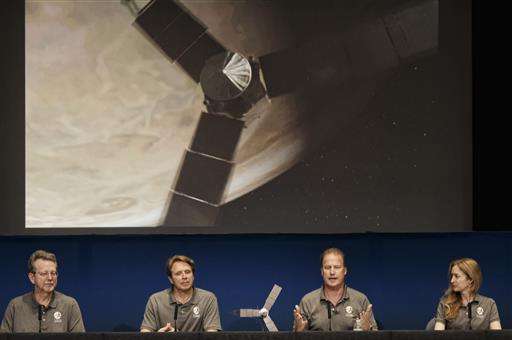
A solar-powered spacecraft is spinning toward Jupiter for the closest encounter with the biggest planet in our solar system.
NASA's Juno spacecraft will fire its main rocket engine late Monday to slow itself down from a speed of 150,000 mph (250,000 kph) and slip into orbit around Jupiter. With Juno on autopilot, the delicately choreographed move comes without any help from ground controllers.
The spacecraft is traveling through a hostile radiation environment and rings of debris and dust, "making for very serious hazards," Juno chief scientist Scott Bolton said during a morning briefing. But Juno should be able to withstand the harsh conditions because it's "built like an armored tank," he said.
The spacecraft's camera and other instruments were switched off for arrival, so there won't be any pictures at the moment it reaches its destination. But NASA released a series of images taken last week during the approach, showing Jupiter glowing yellow in the distance, circled by its four inner moons.
Scientists also have promised close-up views of the planet when Juno skims the cloud tops during the 20-month, $1.1 billion mission.
The fifth rock from the sun and the heftiest planet in the solar system, Jupiter is what's known as a gas giant—a ball of hydrogen and helium—unlike rocky Earth and Mars.
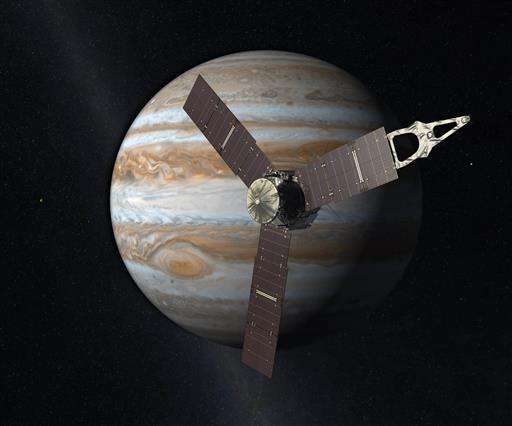
With its billowy clouds and colorful stripes, Jupiter is an extreme world that likely formed first, shortly after the sun. Unlocking its history may hold clues to understanding how Earth and the rest of the solar system developed.
Named after Jupiter's cloud-piercing wife in Roman mythology, Juno is only the second mission designed to spend time at Jupiter.
Galileo, launched in 1989, circled Jupiter for 14 years, beaming back splendid views of the planet and its numerous moons. It uncovered signs of an ocean beneath the icy surface of the moon Europa, considered a top target in the search for life outside Earth.
Juno's mission: To peer through Jupiter's cloud-socked atmosphere and map the interior from a unique vantage point above the poles. Among the lingering questions: How much water exists? Is there a solid core? Why are Jupiter's southern and northern lights the brightest in the solar system?
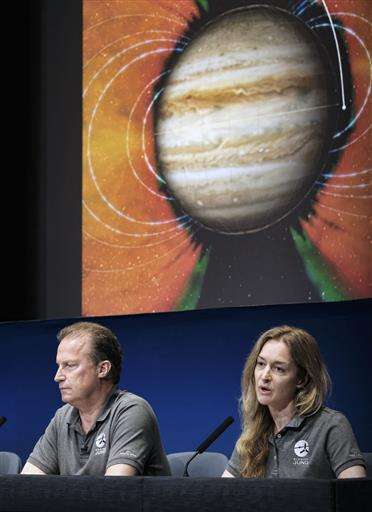
"What Juno's about is looking beneath that surface," Bolton said. "We've got to go down and look at what's inside, see how it's built, how deep these features go, learn about its real secrets."
There's also the mystery of its Great Red Spot. Recent observations by the Hubble Space Telescope revealed the centuries-old monster storm in Jupiter's atmosphere is shrinking.
The trek to Jupiter, spanning nearly five years and 1.8 billion miles (2.8 billion kilometers), took Juno on a tour of the inner solar system followed by a swing past Earth that catapulted it beyond the asteroid belt between Mars and Jupiter.
Along the way, Juno became the first spacecraft to cruise that far out powered by the sun, beating Europe's comet-chasing Rosetta spacecraft. A trio of massive solar wings sticks out from Juno like blades from a windmill, generating 500 watts of power to run its nine instruments.
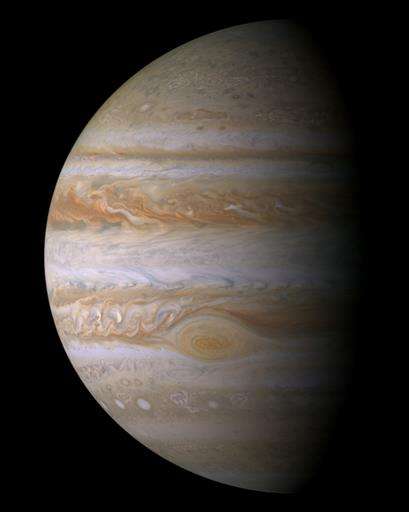
Plans called for Juno to swoop within 3,000 miles (5,000 kilometers) of Jupiter's clouds—closer than previous missions—to map the planet's gravity and magnetic fields.
Juno, built by Lockheed Martin, is an armored spacecraft—its computer and electronics are locked in a titanium vault to shield them from harmful radiation. Even so, Juno is expected to get blasted with radiation equal to more than 100 million dental X-rays during the mission.
Like Galileo before it, Juno meets its demise in 2018 when it deliberately dives into Jupiter's atmosphere and disintegrates—a necessary sacrifice to prevent any chance of accidentally crashing into the planet's potentially habitable moons.
-
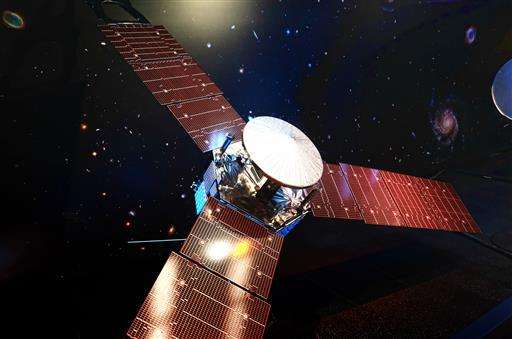
A 1/5 scale model size of NASA's solar-powered Juno spacecraft is displayed at the Jet Propulsion Laboratory in Pasadena, Calif. on Friday, July 1, 2016. The spacecraft is on the final leg of a five-year, 1.8 billion-mile voyage to the biggest planet in the solar system. It's expected to reach Jupiter and go into orbit around the planet on July 4. (AP Photo/Richard Vogel) -
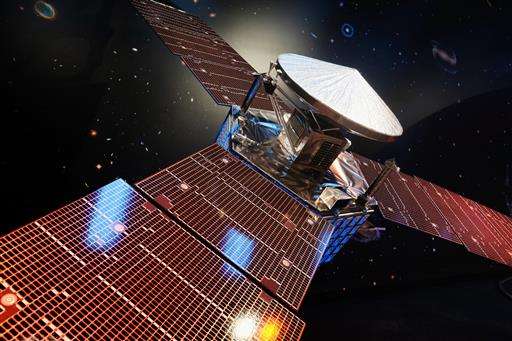
A 1/5 scale model size of NASA's solar-powered Juno spacecraft is displayed at the Jet Propulsion Laboratory in Pasadena, Calif. on Friday, July 1, 2016. The spacecraft is on the final leg of a five-year, 1.8 billion-mile voyage to the biggest planet in the solar system. It's expected to reach Jupiter and go into orbit around the planet on July 4. (AP Photo/Richard Vogel) -
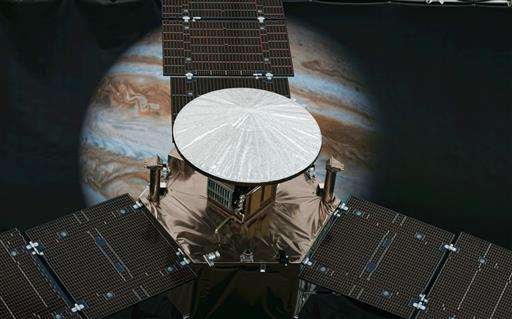
A 1/4 scale model size of NASA's solar-powered Juno spacecraft is displayed at the Jet Propulsion Laboratory in Pasadena, Calif. on Friday, July 1, 2016. The spacecraft is on the final leg of a five-year, 1.8 billion-mile voyage to the biggest planet in the solar system. It's expected to reach Jupiter and go into orbit around the planet on July 4. (AP Photo/Richard Vogel) -
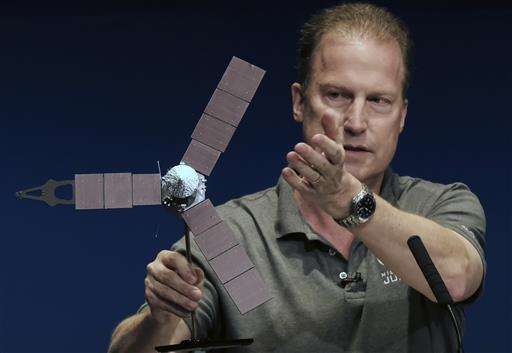
Rick Nybakken, Juno project manager, holds a model of the Juno spacecraft while talking about the solar panels and the orbit it will take around Jupiter during a briefing at the Jet Propulsion Laboratory in Pasadena, Calif., on Monday, July 4, 2016. The solar-powered spacecraft is on it's way toward Jupiter for the closest encounter with the biggest planet in our solar system. NASA's Juno spacecraft will fire its main rocket engine late Monday to slow itself down from a speed of 150,000 mph (250,000 kph) and slip into orbit around Jupiter. (AP Photo/Richard Vogel) -
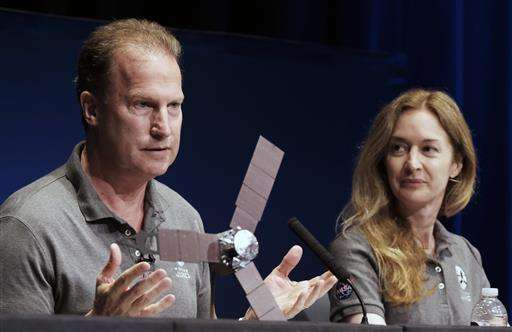
Rick Nybakken, Juno project manager, left, talks about the Juno spacecraft's orbit while Heidi Becker, Juno radiation monitoring investigation lead, looks on during a briefing at the Jet Propulsion Laboratory in Pasadena, Calif., on Monday, July 4, 2016. The solar-powered spacecraft is on it's way toward Jupiter for the closest encounter with the biggest planet in our solar system. NASA's Juno spacecraft will fire its main rocket engine late Monday to slow itself down from a speed of 150,000 mph (250,000 kph) and slip into orbit around Jupiter. (AP Photo/Richard Vogel) -
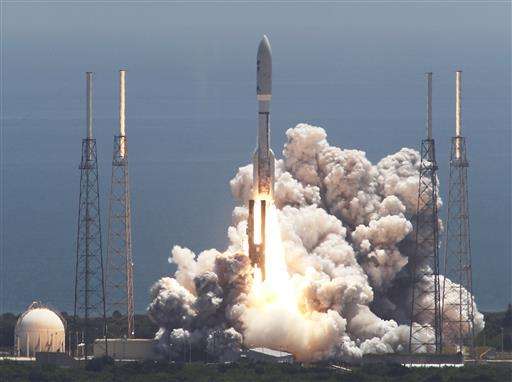
In this Friday, Aug. 5, 2011 file photo, an Atlas V rocket carrying the Juno spacecraft lifts off from Space Launch Complex-41 in Cape Canaveral, Fla. It was the first step in Juno's 1.7 billion-mile voyage to the gas giant planet, Jupiter. (AP Photo/Terry Renna)
More information: Mission page: tinyurl.com/Jupitermission
© 2016 The Associated Press. All rights reserved.



















